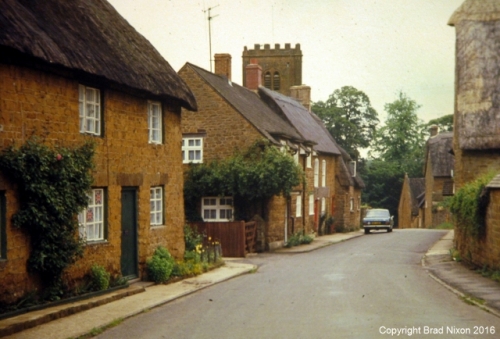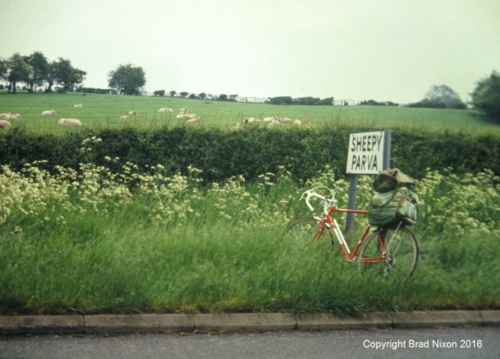As one travels, often taking the unplanned route from HERE to THERE results in the happiest discoveries.
In a long-ago summer, I was approaching Birmingham, heading generally southward to that perpetual bourne of every English major, Stratford-upon-Avon. I was coming from Coalville, northeast of Birmingham, where I had been “stopping” (British for “staying” or “visiting”) with some of the people who knew my English grandmother in her childhood.
I was on a bicycle, which, just as one might expect, is a charming and intimate way to experience the compact and beautiful countryside of Merrie Olde. It can also be, as cyclists everywhere know, a daunting and life-threatening exercise when one has to deal with riding along roadways busy with motorized traffic. Therefore, I picked as many rural routes as I could. This strategy at once minimizes some of the automotive encounters and maximizes exposure to the environment of the utterly and almost too-charming-to-be-real ambience of the English countryside.
Part of the charm of England relates to its weather, which, frankly, is not always so pleasant. This was midsummer, meaning only that it might not snow. Everything else was definitely on the table. The forecasts on the BBC are one of the lesser-known delights of human endeavor (or endeavour, there). A typical example is something like, “Variously cloudy with occasions of some showers and locally changeable storms and bright intervals.” If English weather had a theme song, it would be, “Anything Goes.”
So I rode, sometimes in sun and sometimes in rain, but usually with low-hanging clouds just brushing the top of my head. I discovered wonderful places. For example, after leaving Stratford, I happened on the village of Wroxton, just on the outskirts of Banbury, where I ended up staying two days, both because it was such a lovely spot and because I had had enough rain and was waiting for one of those “bright intervals” to come along and save me from pedaling in the constant drizzle.

Old local stonework, thatched roofs, naturally a friendly little pub with an avid band of local darts aficionados: perfect. It’s the sort of discovery one makes when not zooming along highways in a car — so long as one accepts that there are LOTS of things one WON’T see because you don’t cover as much ground. (Find Wroxton, UK on Google Maps and you’ll be able to see photos taken on brighter days by souls more favored by the weather than I.)
Place names in England are one of the especially wonderful things one encounters there. How those names originated often relies on the fact that the places have been occupied for a long time, and may derive from Celtic, Latin, French, or Old or Middle English originals. Some of my favorite examples are a number of places named “Chipping:” Chipping Norton, Chipping Sodbury, and so forth. Here (and LaBoheme will be paying attention) the word derives from Old English ceapen (pronounced CHAPE-en), meaning “market,” and was associated with market towns. “Cheapening” persisted a good while in English as a term for buying and selling.
Earlier, though, halfway to Birmingham, picking my way along secondary roads, I found perhaps my favorite place names of all time, the Sheepys: Sheepy Magna and Sheepy Parva. Here’s my bike leaning against the sign for Little Sheepy:

It being a lucky day, that meadow beyond the hedge illustrates the origin of the Sheepys’ names: those are sheep. According to the online history of the Sheepys (CLICK HERE), there have been settlements there a long time, probably since the Celtic, pre-Roman era, so the names derive from — again — Old English sceap-eg (SHAPE-aydge), meaning sheep meadow (interestingly both our Old English words today, sceap and ceapan, demonstrate the different sh- and -ch sounds of that language). Whether the locals originally called them Big Sheepy and Little Sheepy, and whether the Romans or the official court records that would have been in Latin at one time assigned them “Magna” and “Parva,” I can’t say. You can still hear that “shape” pronunciation of the word “sheep” widely scattered in both Britain and parts of the American south, a direct survivor of how the language was spoken a thousand years ago.
Here, in a not very successful slide transfer, is Sheepy Magna:

These photos were made almost 40 years ago, but I hope the places still retain their charm and local character. There are some other wonderful place names immediately adjacent to the Sheepys, including Ratcliffe Culey (Old English “red cliff:”) and The Mythe (also probably an OE origin), not to mention a place where Richard III reportedly bathed (swam) named King Dick’s Hole, but, unfortunately I missed those by pressing on to Stratford.
Keep your eyes open as you travel, and be ready to stop, even if it’s raining. A bright interval will be along soon.
Postscript, June, 2012: former colleague, regular blogger and biking adventurer, Nick lives in England, 27 miles from the Sheepys. He visited the Sheepys and posted a contemporary photo of this same location: http://nicktickner.wordpress.com/2012/06/23/a-tale-of-two-sheepys/
© Brad Nixon 2012, 2017
I can’t get enough of the English countryside – especially on a bike. Partly for the scenery, but also for these little villages that you just can’t help passing through regularly once you’re off the main roads. Wootton Wawen, Morton Bagot, etc. It’s easy to find the inspiration for Adams’ The Meaning of Liff
LikeLike
By: Nick on May 5, 2012
at 4:40 am
I always enjoy your travelogs. Amazing what you remember from 35 years ago. Way better than my memory! 🙂
LikeLike
By: La Boheme on May 8, 2012
at 9:06 am
[…] Here’s my not-so-subtle tribute to Mr Nixon: […]
LikeLike
By: A Tale of Two Sheepys | Thoughts While Shaving on June 23, 2012
at 5:39 am